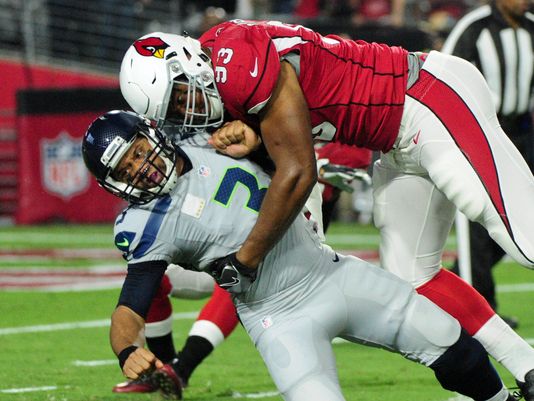Let’s cut through all the introductory etiquette and get right to the point: the Seattle Seahawks have an offensive line problem. More specifically, they have an offensive tackle problem. After what seemed like a historically awful offensive performance, the Hawks will undoubtedly be evaluating all of their options. On top of that, Bradley Sowell will be out several weeks with an MCL sprain. That leaves undrafted free agent Goerge Fant, a former college basketball player, to slide in at left tackle and protect one the franchise’s most coveted players. Well, this should be interesting.
Two names floating around as potential trade targets at left tackle are 49er Joe Staley and Joe Thomas from the Browns. Both, at a minimum, are legitimately good to great left tackles and would be immediate upgrades on the offensive line. I’m not going to argue whether they should or should not make this trade, but rather just assume that you want it to happen. Let’s break down the financials.
Step 1: How much do the Seahawks have in cap space?
Right now, according to my own spreadsheets, I have the Hawks with $7.8M in true cap space — give or take a million. Many financial aspects that determine cap space are publicly unavailable to us – so it’s important to give some wiggle room. I’m mainly referring to two things here: 1) LTBE (likely-to-be-earned) incentives in player contracts that are accounted for at the beginning of the year and 2) Injury settlements.
With the information available to us, the Seahawks likely have around $7.8M in true cap space (and that includes IR and all that fun stuff).
Step 2: How much would Joe Staley or Joe Thomas cost?
Let’s start with 49ers’ left tackle Joe Staley.
Staley is currently in year three of a six year contract worth $44,650,000. His contract runs through 2018 and actually dips in cap hits the last two years. So…let’s assume he’s traded to the Hawks. The signing bonus was already paid by the 49ers so Seattle is off the hook for that. For 2016, that leaves a $5,400,000 base salary and a $500,000 roster bonus (the workout bonus was already paid). That totals a $5.9M cap hit for 2016. However, the base salary and his roster bonus are paid on a divided weekly basis. And Joe has already played seven games.
Divide $5.9M by 17 weeks of work and Staley is making $347,058 a week. But remember, he’s already played for seven weeks and Seattle would only be paying him for ten more games in 2016.
Multiply ten weeks of work by his weekly pay ($347,058) and you get Staley’s cap hit against the Seahawks for the 2016 season: $3,470,580. Remember, Seattle has around $7.8M in cap space for 2016. The Hawks have around double the amount of cap room needed to fit his contract under the 2016 cap. In 2017, he would carry a $8.95M cap charge against the Hawks. In 2018 and 2019, he would cost the Hawks only $5.5M against the cap in each respective year. Definitely doable.
Now let’s move onto Joe Thomas.
If the left tackle were to be traded from Cleveland, he would carry a $9.3M cap hit against the Seahawks in 2016. Remember though, we’re not paying him for a full seventeen weeks. He’s already played seven games. Divide his $9.3M cap hit by 17 weeks of pay and you get $547,058 a week. Multiply that weekly pay number by ten remaining weeks of play and you get Thomas’ 2016 cap hit against the Seahawks: $5,470,580. In 2017 and 2018, he would carry cap hits of $10M against Seattle in each respective year.
Now remember, the Hawks have around $7.8M in 2016 cap space. Based off the over $2M difference in room and 2016 salary for Thomas, it is my understanding that the Seahawks could slide his contract under the 2016 cap without any alterations to any other contracts.
Step 3: Let’s review the conclusions we just came to
The Hawks have $7.8M in cap space. LT Joe Staley would cost $3,470,580 for the remainder of the 2016 season (financially feasible). On the other hand, LT Joe Thomas would cost $5,470,580 for the remainder of the 2016 season (also financially feasible). The main notable difference between these two player contracts is their cap hits in future years. The last two years of the Staley contract would cost Seattle only $5.5M in each year – opposed to the $10M price tag in the last two years on Thomas.
Both players could come into Seattle and they’re wouldn’t need to be any major shakeups to any other player contracts. In my opinion, it all comes down to their price. Would Cleveland part with Thomas for a 2nd round pick? If so, I hope John is on the phone right now. On the other hand, the 49ers are reportedly putting a first round price tag on Staley. That seems a bit steep. One thing I know for sure: this Seattle defense might be just as good as the 2013 unit. Let’s not waste the primes of these defensive stars.
